- Home
- Raymond Chandler
The Annotated Big Sleep Page 3
The Annotated Big Sleep Read online
Page 3
14. Hammett had been writing for Black Mask since the early twenties, before Hemingway’s work was known in America, but his writing becomes far less formulaic—not to say less hackneyed—after Hemingway.
15. From his Notebooks (1976), 23. The quotation heads a piece of parody, but the comment is sincere. See also page 21.
16. The Sun Also Rises (2003), 42. Ezra Pound’s 1938 Guide to Kulchur defines “stoic” as “a hard-boiled partial disposition insensitive to a great part of the spectrum both intellectual and emotional” (1968), 25. Chandler will play with the term throughout the Marlowe novels, with the detective usually commenting ironically on it. For example, in Farewell, My Lovely, Marlowe admires Mrs. Grayle’s “way of talking, cool, half-cynical, and yet not hard-boiled” (unlike Joe Brody’s affected voice in TBS). Later in the novel, he will facetiously say, “I like smooth shiny girls, hard-boiled and loaded with sin.” See also this exchange from The Little Sister: “ ‘I heard you were kind of hard-boiled,’ Toad said slowly, his eyes cool and watchful.” Marlowe: “You heard wrong. I’m a very sensitive guy. I go all to pieces over nothing.” Marlowe’s facetiousness—itself a species of hard-boiled—perfectly captures the ironic self-awareness of Chandler’s literary practice.
17. Hard-boiled eggs also make a suggestive appearance in the 1982 neo-noir film Blade Runner.
18. Ross Macdonald (1915–83; real name Kenneth Millar), the first great successor to Chandler and Hammett, is one of the few hard-boiled practitioners who credited both Crane and Norris: Crane with teaching him “the modern American style based on the speaking voice,” and Norris with calling for “a popular and democratic literature.” See Matthew J. Bruccoli and Richard Layman, eds., Hardboiled Mystery Writers Raymond Chandler, Dashiell Hammett, Ross Macdonald: A Literary Reference (2002), 247–49.
19. See Tom Hiney, Raymond Chandler: A Biography (1997), 107–8.
20. The publishers liked the review, however. It is quoted on the rear jacket flap to The Lady in the Lake (1944).
21. See Leonard Cassuto’s lively discussion in his essay “Raymond Chandler,” in Timothy Parrish, The Cambridge Companion to American Novelists (2012).
ADDITIONAL RAYMOND CHANDLER WORKS REFERENCED IN THE ANNOTATIONS
(Bold indicates stories excerpted in text boxes.)
SHORT STORIES
“Blackmailers Don’t Shoot” (Black Mask, 1933), featuring Detective Mallory.
“Finger Man” (Black Mask, 1934), originally featuring an unnamed protagonist later named Philip Marlowe in the Simple Art of Murder anthology (1950).
“Killer in the Rain” (Black Mask, 1935), originally featuring an unnamed protagonist before being incorporated into The Big Sleep.
“Nevada Gas” (Black Mask, 1935), featuring gambler Johnny DeRuse.
“Guns at Cyrano’s” (Black Mask, 1936), originally featuring ex–private detective Ted Malvern, later changed to Ted Carmady for The Simple Art of Murder.
“Goldfish” (Black Mask, 1936), originally featuring Detective Ted Carmady, later changed to Philip Marlowe for The Simple Art of Murder.
“The Curtain” (Black Mask, 1936), as “Goldfish,” above.
“Try the Girl” (Black Mask, 1937), originally featuring Detective Ted Carmady before being incorporated into Farewell, My Lovely.
“Mandarin’s Jade” (Dime Detective, 1937), originally featuring Detective Johnny Dalmas before being incorporated into Farewell, My Lovely.
“The Lady in the Lake” (Dime Detective, 1939), originally featuring Detective Johnny Dalmas before being incorporated into The Lady in the Lake.
“Pearls Are a Nuisance” (Dime Detective, 1939), featuring playboy Walter Gage.
NOVELS
Farewell, My Lovely (1940)
The High Window (1942)
The Lady in the Lake (1943)
The Little Sister (1949)
The Long Goodbye (1953), not originally a Philip Marlowe novel. In drafting it, Chandler felt that he wasn’t connected to the main character, so he rewrote it from Marlowe’s point of view. “It begins to look as though I were tied to this fellow for life,” he wrote. “I simply can’t function without him.”
Playback (1958), originally a film script from 1947, not featuring Philip Marlowe.
“The Poodle Springs Story” (unfinished at death), completed by Robert B. Parker and published as Poodle Springs (1990).
Title page of the first edition
1. When TBS came out, the name of Raymond Chandler was known only to devotees of pulp magazines, specifically those who read Black Mask and Dime Detective. The dust jacket of the first hardcover edition introduced him thus: “Raymond Chandler has had that type of career which is commonly referred to as ‘checkered.’ Born in Chicago of an Irish mother and an American father, he went early to England, where eventually he attended Dulwich College. After completing his education in France and Germany, he turned first to school-teaching as a profession”—for which there’s no evidence, but it sounded better than a job in the civil service, one supposes—“but soon gave that up in favor of writing. He became successively a book-reviewer, poet, paragraph-writer, and essayist.” The blurb notes that he fought in World War I in the Canadian infantry and returned to the United States, emphasizing his subsequent white-collar employments, including oil executive, and leaving out apricot picker and tennis racket stringer. Despite this checkered past, Chandler looked every bit the bookish intellectual that he was. He wrote in a letter, “Why in God’s name don’t those idiots of publishers stop putting photos of writers on their dust jackets? I bought a perfectly good book…was prepared to like it…and then I take a fast gander on the guy’s picture and he is obviously an absolute jerk, a really appalling creep…and I can’t read the damn book.” There was no author photo on the jacket. The bio concludes: “The Big Sleep is his first novel.”
2. Slang for death. This is the first known use of this term in print, as Chandler insisted, irritated at Eugene O’Neill’s lifting of the phrase in The Iceman Cometh (written later in 1939). “If I am remembered long enough,” Chandler would sigh a decade later, “I shall probably be accused of stealing the phrase from O’Neill, since he is a big shot.”
The phrase may owe something to Dashiell Hammett’s novella The Big Knockover, published in 1927. Following the success of the 1946 Howard Hawks film based on Chandler’s novel, “The Big X” became a template for film noir titles. Some notable examples: The Big Steal (1949), The Big Knife (1955, based on Clifford Odets’s 1949 play of the same name), The Big Heat (1953), and The Big Combo (1955). Mickey Spillane helped forward the trend with his fifth Marlowe-inspired Mike Hammer novel, The Big Kill (1951). More recent homages include The Big Lebowski (1998) and the Japanese noir-manga The Big O (1999–2001). The Big Con, a sociological study of the criminal underworld by David W. Maurer, appeared the year after The Big Sleep, in 1940.
There are a whopping fourteen euphemistic “big”s listed in Albin J. Pollock’s 1935 dictionary of crime slang, The Underworld Speaks (e.g., “Big house, prison”). “Big sleep” isn’t one of them.
3. Then as now, New York was the center of publishing in the United States, but the greatest practitioners of hard-boiled fiction migrated to California from points east: not just, most famously, Chandler and Hammett, but other Black Mask stars such as James M. Cain, Paul Cain, and Horace McCoy.
4. Alfred A. Knopf founded his publishing company in 1915 after working as an editor at Doubleday. In Chandler’s day, Knopf also published James M. Cain and Dashiell Hammett, as well as distinguished American authors such as Willa Cather, Langston Hughes, and Ezra Pound. It was a significant move away from the pulp pages for Chandler.
Hardcovers were expensive (TBS cost two dollars, the equivalent of about $34.50 today), so paperbacks were brought in in the late 1930s to reach a wider audience, including the readers of the pulps. There w
asn’t a lot of quality control in genre-lit publishing, as Chandler noted: “The average detective story is probably no worse than the average novel, but you never see the average novel. It doesn’t get published. The average or only slightly above average detective story does.” In the 1920s and ’30s most major American publishers were publishing detective stories. Alfred’s wife, Blanche Knopf, had an important role in editing Knopf authors and corresponded with Chandler.
Copyright page of the first edition
5. Specifically, February 6 in the United States; Hamish Hamilton brought out the British edition the following month. The Great Depression, which had engulfed the United States and the wider Western world in economic devastation since 1929, was not yet over. Fascism was on the rise: the Spanish Civil War ended with the Nationalists on top; Nazi Germany took over Czechoslovakia; Hitler’s ally Mussolini invaded Albania. The United States remained isolationist, refusing entry of Jewish refugees on board the St. Louis (the infamous “Voyage of the Damned”). Later in the year, Hitler invaded Poland, officially beginning World War II in Europe. Although TBS doesn’t reference this context, Chandler watched the world situation with alarm. He wrote to Blanche Knopf, “The effort to keep my mind off the war has reduced me to the mental age of seven.”
1939 is widely considered the best year in American film history, with ten Academy Award nominations for Best Picture, including The Wizard of Oz, Stagecoach with John Wayne, Of Mice and Men, Wuthering Heights, and the winner, Gone With the Wind. Americans spent more money going to movies in 1939 than they ever had before.
1939 was also a big year for representations of California in literature. Besides TBS, there was John Steinbeck’s Depression novel The Grapes of Wrath, which won both the National Book Award and the Pulitzer Prize; Nathanael West’s Hollywood novel The Day of the Locust; John Fante’s Ask the Dust, about hard times in Los Angeles; and Aldous Huxley’s damning portrayal of an aging Hollywood millionaire, After Many a Summer. Additionally, James Joyce’s linguistic romp Finnegans Wake was brought out by Faber and Faber in Britain and Viking Press in the United States.
Mobster Al Capone was released from prison; mob fixer James Joseph Hines went in.
Review copy wrapper
1. Review copies were sent out with a special cover with text that was also used as ad copy. Knopf chose to give TBS a big buildup, and Chandler was thrust into the canon of bestselling crime writers before official publication of his first novel. Perhaps this was at the instigation of editor Blanche Knopf, who was the force behind signing Hammett, Cain, and Chandler, and who began Knopf’s policy of publishing the cream of literary hard-boiled fiction.
ONE
IT WAS ABOUT ELEVEN O’CLOCK in the morning, mid October,1 with the sun not shining and a look of hard wet rain in the clearness of the foothills.2 I was wearing my powder-blue suit, with dark blue shirt, tie and display handkerchief, black brogues, black wool socks with dark blue clocks on them.3 I was neat, clean, shaved and sober, and I didn’t care who knew it. I was everything the well-dressed private detective ought to be.4 I was calling on four million dollars.5
The main hallway of the Sternwood place was two stories high. Over the entrance doors, which would have let in a troop of Indian elephants,6 there was a broad stained-glass panel showing a knight in dark armor rescuing a lady who was tied to a tree and didn’t have any clothes on but some very long and convenient hair. The knight had pushed the vizor of his helmet back to be sociable, and he was fiddling with the knots on the ropes that tied the lady to the tree and not getting anywhere. I stood there and thought that if I lived in the house, I would sooner or later have to climb up there and help him. He didn’t seem to be really trying.7
There were French doors at the back of the hall, beyond them a wide sweep of emerald grass to a white garage, in front of which a slim dark young chauffeur in shiny black leggings was dusting a maroon Packard convertible.8 Beyond the garage were some decorative trees trimmed as carefully as poodle dogs. Beyond them a large greenhouse with a domed roof. Then more trees and beyond everything the solid, uneven, comfortable line of the foothills.9
On the east side of the hall a free staircase, tile-paved, rose to a gallery with a wrought-iron railing and another piece of stained-glass romance. Large hard chairs with rounded red plush seats were backed into the vacant spaces of the wall round about. They didn’t look as if anybody had ever sat in them. In the middle of the west wall there was a big empty fireplace with a brass screen in four hinged panels, and over the fireplace a marble mantel with cupids at the corners. Above the mantel there was a large oil portrait, and above the portrait two bullet-torn or moth-eaten cavalry pennants crossed in a glass frame. The portrait was a stiffly posed job of an officer in full regimentals of about the time of the Mexican war.10 The officer had a neat black imperial, black mustachios, hot hard coal-black eyes, and the general look of a man it would pay to get along with. I thought this might be General Sternwood’s grandfather.11 It could hardly be the General himself, even though I had heard he was pretty far gone in years to have a couple of daughters still in the dangerous twenties.
I was still staring at the hot black eyes when a door opened far back under the stairs. It wasn’t the butler coming back. It was a girl.
She was twenty or so, small and delicately put together, but she looked durable. She wore pale blue slacks and they looked well on her. She walked as if she were floating. Her hair was a fine tawny wave cut much shorter than the current fashion of pageboy tresses curled in at the bottom.12 Her eyes were slate-gray, and had almost no expression when they looked at me. She came over near me and smiled with her mouth and she had little sharp predatory teeth, as white as fresh orange pith13 and as shiny as porcelain. They glistened between her thin too taut lips. Her face lacked color and didn’t look too healthy.14
“Tall, aren’t you?” she said.15
“I didn’t mean to be.”16
Her eyes rounded. She was puzzled. She was thinking. I could see, even on that short acquaintance, that thinking was always going to be a bother to her.
“Handsome too,”17 she said. “And I bet you know it.”
I grunted.
“What’s your name?”
“Reilly,” I said. “Doghouse Reilly.”18
“That’s a funny name.” She bit her lip and turned her head a little and looked at me along her eyes. Then she lowered her lashes until they almost cuddled her cheeks and slowly raised them again, like a theater curtain. I was to get to know that trick. That was supposed to make me roll over on my back with all four paws in the air.
“Are you a prizefighter?”19 she asked, when I didn’t.
“Not exactly. I’m a sleuth.”20
“A—a—” She tossed her head angrily, and the rich color of it glistened in the rather dim light of the big hall. “You’re making fun of me.”
“Uh-uh.”
“What?”
“Get on with you,” I said. “You heard me.”
“You didn’t say anything. You’re just a big tease.” She put a thumb up and bit it. It was a curiously shaped thumb, thin and narrow like an extra finger, with no curve in the first joint. She bit it and sucked it slowly, turning it around in her mouth like a baby with a comforter.21
“You’re awfully tall,” she said. Then she giggled with secret merriment. Then she turned her body slowly and lithely, without lifting her feet. Her hands dropped limp at her sides. She tilted herself towards me on her toes. She fell straight back into my arms. I had to catch her or let her crack her head on the tessellated floor.22 I caught her under her arms and she went rubber-legged on me instantly. I had to hold her close to hold her up. When her head was against my chest she screwed it around and giggled at me.
“You’re cute,” she giggled. “I’m cute too.”
I didn’t say anything. So the butler chose that conv
enient moment to come back through the French doors and see me holding her.
It didn’t seem to bother him. He was a tall, thin, silver man, sixty or close to it or a little past it. He had blue eyes as remote as eyes could be. His skin was smooth and bright and he moved like a man with very sound muscles. He walked slowly across the floor towards us and the girl jerked away from me. She flashed across the room to the foot of the stairs and went up them like a deer. She was gone before I could draw a long breath and let it out.
The butler said tonelessly: “The General will see you now, Mr. Marlowe.”23
I pushed my lower jaw up off my chest and nodded at him. “Who was that?”
“Miss Carmen Sternwood,24 sir.”
“You ought to wean her. She looks old enough.”25
He looked at me with grave politeness and repeated what he had said.
1. The convention of telling the time throughout the mystery story begins with Poe (especially “The Mystery of Marie Rogêt,” 1842–43) and is continued throughout Doyle’s Sherlock Holmes stories; it suggests the precision of the police procedural and of crime journalism. It also places the reader in the concrete here-and-now of the narrative. Georges Simenon’s 1931 The Yellow Dog begins, “Friday, November 7. Concarneau is empty. The lighted clock in the Old Town glows above the ramparts; it is five minutes to eleven.” The first paragraph of Chester Himes’s The Crazy Kill (1959): “It was four o’clock, Wednesday morning, July 14th, in Harlem, U.S.A. Seventh Avenue was as dark and lonely as haunted graves.”

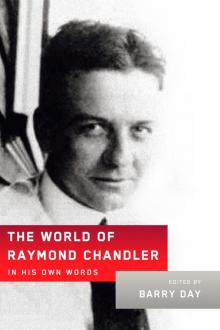 The World of Raymond Chandler: In His Own Words
The World of Raymond Chandler: In His Own Words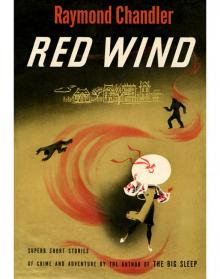 Red Wind: A Collection of Short Stories
Red Wind: A Collection of Short Stories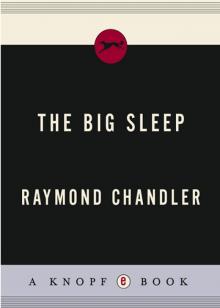 The Big Sleep
The Big Sleep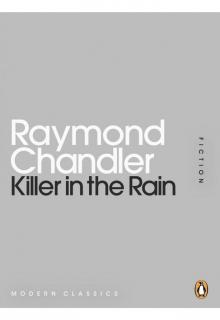 Killer in the Rain
Killer in the Rain Playback
Playback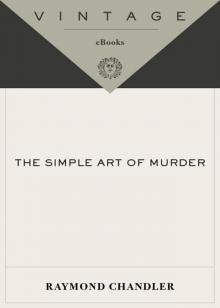 The Simple Art of Murder
The Simple Art of Murder The Bronze Door
The Bronze Door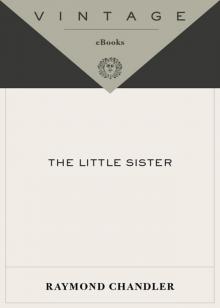 The Little Sister
The Little Sister The Lady in the Lake
The Lady in the Lake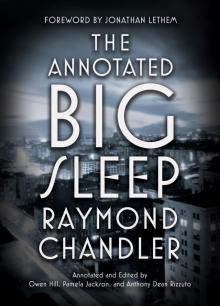 The Annotated Big Sleep
The Annotated Big Sleep The Collected Raymond Chandler
The Collected Raymond Chandler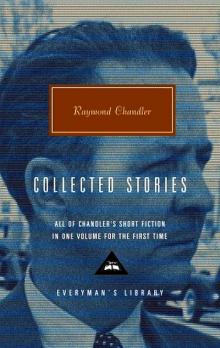 Collected Stories (Everyman's Library)
Collected Stories (Everyman's Library)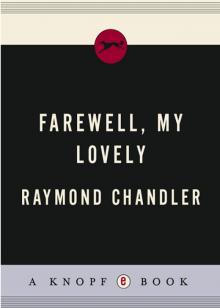 Farewell, My Lovely
Farewell, My Lovely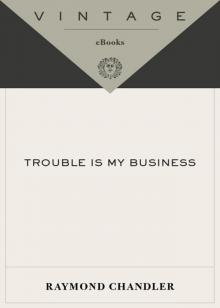 Trouble Is My Business
Trouble Is My Business The Long Goodbye
The Long Goodbye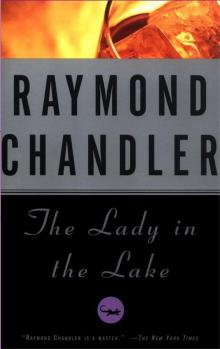 The Lady in the Lake pm-4
The Lady in the Lake pm-4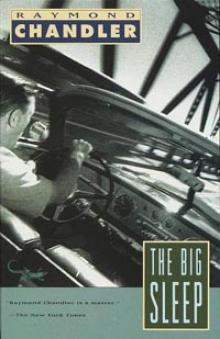 The Big Sleep pm-1
The Big Sleep pm-1 The World of Raymond Chandler
The World of Raymond Chandler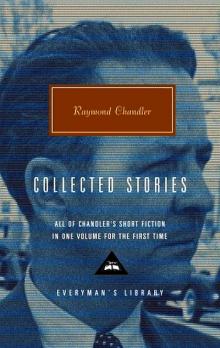 Collected Stories of Raymond Chandler
Collected Stories of Raymond Chandler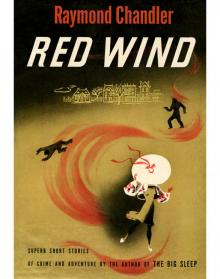 Red Wind
Red Wind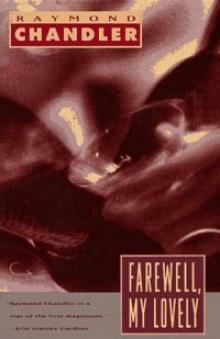 Farewell, My Lovely pm-2
Farewell, My Lovely pm-2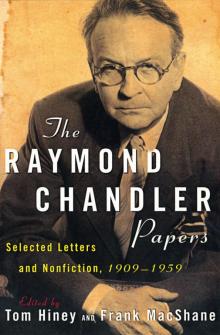 The Raymond Chandler Papers: Selected Letters and Nonfiction, 1909–1959
The Raymond Chandler Papers: Selected Letters and Nonfiction, 1909–1959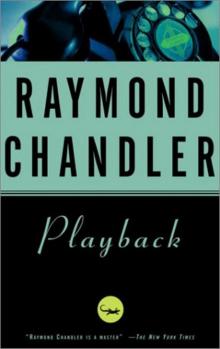 Playback pm-7
Playback pm-7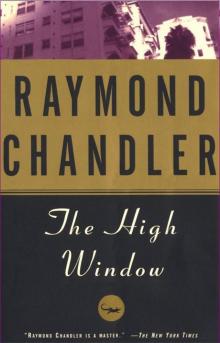 The High Window pm-3
The High Window pm-3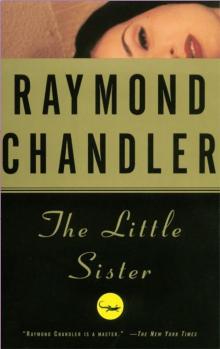 The Little Sister pm-5
The Little Sister pm-5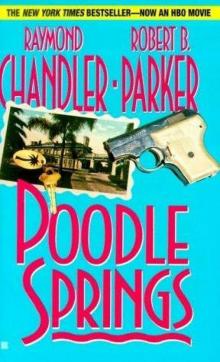 Poodle Springs (philip marlowe)
Poodle Springs (philip marlowe)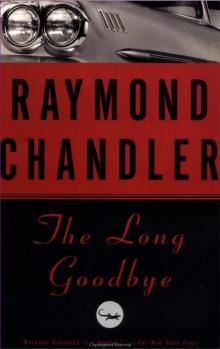 The Long Goodbye pm-6
The Long Goodbye pm-6